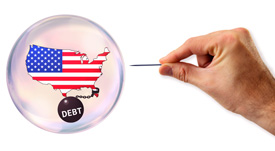By Money Metals News Service – Gold bugs are arriving at the end of both a year and an extraordinary decade. Precious metals prices had a roller coaster ride over the past ten years and finished mostly higher despite plenty of pain.
- Gold was priced at $1,096 on January 1, 2010.
- Silver opened the decade at $16.85, then spiked to over $49.00/oz before collapsing under $14… only to finish the decade around $18.
- Palladium enjoyed an extraordinary run higher from $406/oz to all-time highs at nearly $2,000 late this year.
- Platinum stumbled and fell, dropping from $1,467/oz ten years ago to under $1,000 today.
Metals prices reflected three overarching stories in markets…
The decade past was dominated by central planning, crooked bankers, and exploding debt at all levels.

Metals investors are wondering just how much longer this game can continue. Policy makers and the Wall Street elite will have their work cut out for them if they seek to stay the course with another ten years of exponential debt growth and micro-managed markets. There are, however, no signs they intend to change direction.
Ten years ahead is a long way to see, but the coming year could look a lot like what we see in the rear-view mirror.
There was a question about whether the Federal Reserve would actively foment a recession in order to undermine President Trump’s chances for reelection. Stock prices were tanking a year ago as the stimulus-addicted markets suffered withdrawal of Fed liquidity.
Free Reports:
 Get Our Free Metatrader 4 Indicators - Put Our Free MetaTrader 4 Custom Indicators on your charts when you join our Weekly Newsletter
Get Our Free Metatrader 4 Indicators - Put Our Free MetaTrader 4 Custom Indicators on your charts when you join our Weekly Newsletter
 Get our Weekly Commitment of Traders Reports - See where the biggest traders (Hedge Funds and Commercial Hedgers) are positioned in the futures markets on a weekly basis.
Get our Weekly Commitment of Traders Reports - See where the biggest traders (Hedge Funds and Commercial Hedgers) are positioned in the futures markets on a weekly basis.
That question was answered in 2019 when officials appeared to have caved to pressure from the President and from the markets.
The Fed pushed rates lower three times this year. Then it intervened in the repo markets and resumed bond purchases, undoing much of what was done during four years of “Quantitative Tightening.”
Stock prices are the economic indicator that officials care most about. They are prepared to do whatever it takes to keep equity prices from correcting. If that means adding another trillion or two to the Fed balance sheet and a return to zero interest rates, so be it.
Donald Trump has been very critical of Jerome Powell, but the Fed Chair doesn’t seem to be holding grudges. Perhaps he recognizes there is a lot more at stake than politics.
Powell got a rude awakening a year ago after just a little tightening – stocks cratered. Bubbles are easy to blow, but terribly hard to deflate without a catastrophic pop.
The Fed is now working overtime to keep the bubbles growing and control the damage caused by their feeble attempt at tightening. They may yet lose control. The flow of cash being pumped into the repo markets is still expanding, and that implies they aren’t yet out of the woods.
Central planning could fail and the long-delayed reckoning for all of this bubble blowing could arrive at any time.
That is the wild card. If this card isn’t played, the year ahead figures to look like the year past.
There will be lots of political drama in 2020, likely culminating in a victory for Trump as Democrats parade their weak candidates and embarrass themselves with their impeachment obsession.
The question is whether metals can get some attention from speculators despite this as the background.
Gold and silver markets bottomed in 2015. The rally since then has been overshadowed by the rise in stock prices. The metals can continue to perform well in a rising equity environment, but they may stay under the radar until investor focus shifts.
 The Money Metals News Service provides market news and crisp commentary for investors following the precious metals markets.
The Money Metals News Service provides market news and crisp commentary for investors following the precious metals markets.